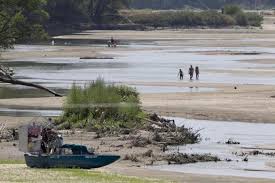Climate Change in US: Divisions To Come
By Doug Struck
Globe Correspondent
It has been too easy—and too true—to imagine that the worst consequences of climate change will not affect us much in the United States. When the changes in our climate begin to sort out winners from losers, we can feel smugly confident.
We are, after all, an immensely affluent nation, with inestimable resources and ingenuity that may cushion us—most of us—from harsh realities. It is the masses living on the borderline of sustenance who will suffer: the 160 million residents of Bangladesh whose productive land is fast surrendering to salty ocean encroachment, the 300,000 Maldivians who will lose their islands to the seas in a few decades, the subsistence farmers in tropical climes who will see their livelihoods and food wither away in dry heat, the thirsty poor in crowded slums whose very access to water will become more difficult as glaciers shrink and rivers dry.
 In this country we have been pampered by natural abundance. And when it wasn’t there, we re-engineered nature to put it there, tunneling through mountains and diverting rivers to grow cities in the desert and make fertile valleys from dry land. Much of the hydrology of the western United States has been engineered by man.
In this country we have been pampered by natural abundance. And when it wasn’t there, we re-engineered nature to put it there, tunneling through mountains and diverting rivers to grow cities in the desert and make fertile valleys from dry land. Much of the hydrology of the western United States has been engineered by man.
But as the changes in our environment become more apparent, our comfort in abundance looks less secure. The New York Times took a broad look this week at a problem we have been loath to confront: the coming disappearance of the once-mighty Colorado River. After a century of abnormal wet years and booming population growth in the West, drier conditions have set in and the river is hurting. The proud symbol of the West is becoming a pitiful trickle unable to supply all of 40 million people in seven states, Phoenix, Las Vegas, Los Angeles as well as millions of acres of irrigated farming.
The plight of the Colorado suggests an unexpected threat to the United States from climate change: division within. The broad trends of our warming climate will be an intensification of the drought and heat in areas that are naturally dry and hot—our Southwest—and an increase in fierce precipitation in wet areas, such as the U.S. Northeast and Northwest.
We may become a country that more resembles a Tale of Two Cities: a parched dry south and middle, and overwatered edges. In New England, the consequence of climate change is expected to be more severe storms and rising tides. In the Southwest, the consequence will be longer droughts, disappearing aquifers and rivers trickling to naught.
But the “haves” and “have-nots” will not be so simply divided. More than 50 percent of the food sales in America come from irrigated lands, areas that cannot reliably produce such vast quantities without water pumps. How many Americans know that the giantOgallala Aquifer, one of the world’s largest, which underlies the farm production in eight Great Plains states, already is running dry in places?
What strains in our national unity will this disparity cause? Will we have the resilience to confront these challenges, when part of our country needs to make preparations for more water while another part needs to gird for less? Can we find the common purpose for different strategies, especially in a poisoned political climate in which half of our congresspersons refuse even to admit the problem?
And that says nothing of a role of global leadership to confront this problem. Though in truth, America already has ceded that role.
Climate change will bring enormous challenges. We should not feel sanguine that we will escape in comfort. On a national level, our leadership has done little to prepare. That mistake may cost us dearly.
(photo: Bostonglobe.com)